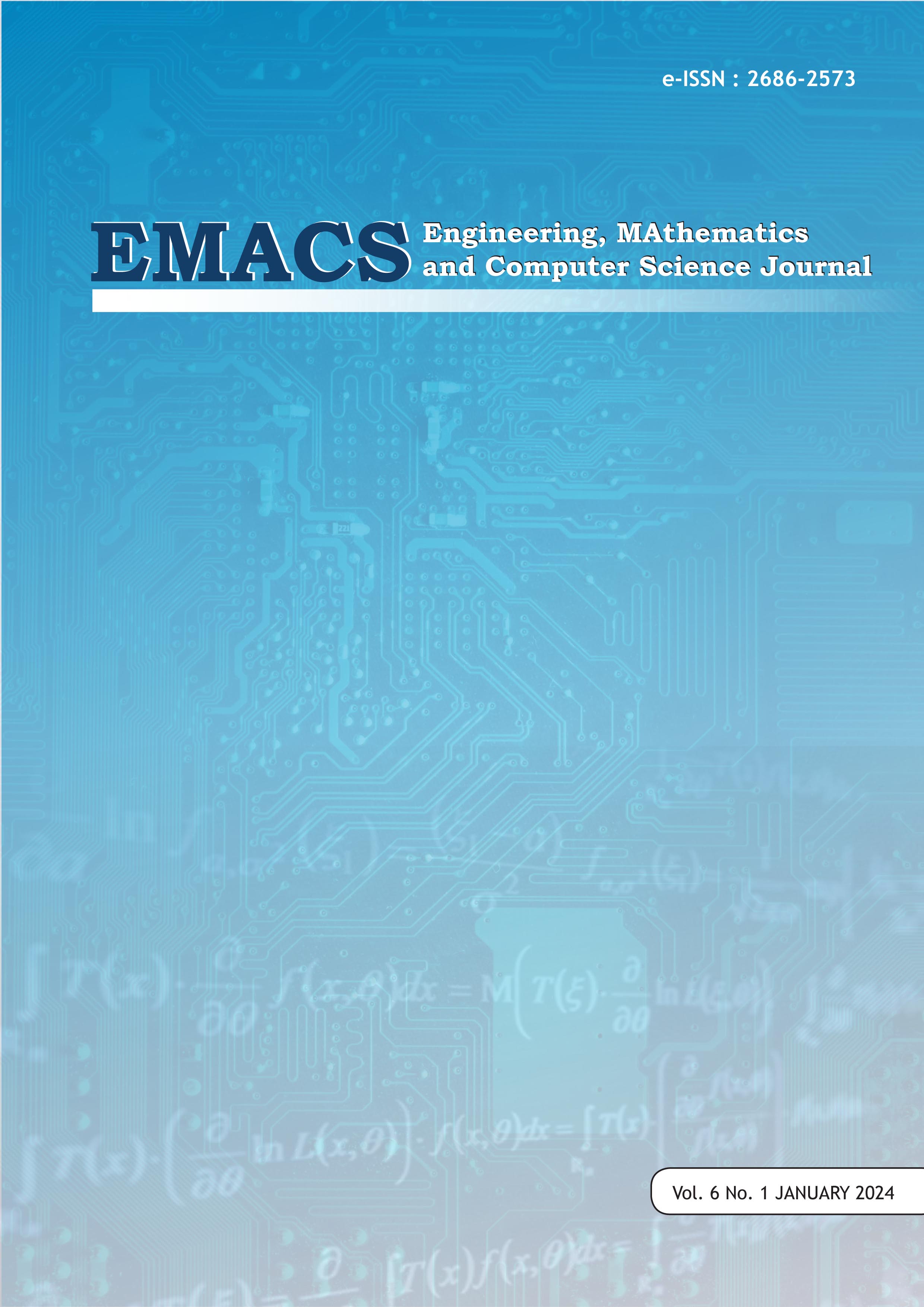An Experiment to Prevent Malicious Actors from Compromising Private Digital Assets Over a Public Network
DOI:
https://doi.org/10.21512/emacsjournal.v6i1.10389Keywords:
Public Network, Digital Safety, OpenVPN, Raspberry Pi, Traffic EncryptionAbstract
In the current millennium, human society has immensely improved its ability to obtain and distribute information. This change on the other hand, has caused the majority of daily routines to actively involve the usage of computers and mobile devices, which in turn has made people rely heavily on the availability of internet access. This fact was taken advantage of, causing a massive increase in public networks by people or businesses to draw in customers or just as simple public service. This increase gives both ease and risks which this paper will address, specifically on the security measures in network devices that are nearby, and the solution proposed to provide complementary insight on securing the technologies. The authors of this paper supply the main point of the research through experimental efforts i.e., by testing the solution in a real-life scenario. The solution itself involves the configuration of a Raspberry Pi into a VPN server and rerouting all traffic into the Raspberry server so that it will be encrypted and safe from the dangers that will be mentioned in later parts of this paper. The result of the experiment shows that the proposed solution can successfully encrypt the targeted packet so it can’t be read by malicious attackers. Although the solution works it can’t be simply applied to every public network due to internet connection protocols and its inconvenience. Future research will involve the improvement or rework of the solution until the issues mentioned above are solved.
References
Ali, S., Osman, T., Mannan, M., & Youssef, A. (2019). On privacy risks of public wifi captive portals. In Data Privacy Management, Cryptocurrencies and Blockchain Technology: ESORICS 2019 International Workshops, DPM 2019 and CBT 2019, Luxembourg, September 26–27, 2019, Proceedings 14 (pp. 80-98). Springer International Publishing. doi: 10.1007/978-3-030-31500-9_6.
Bhushan, B., Sahoo, G., & Rai, A. K. (2017, September). Man-in-the-middle attack in wireless and computer networking—A review. In 2017 3rd International Conference on Advances in Computing, Communication & Automation (ICACCA)(Fall) (pp. 1-6). IEEE. doi: 10.1109/ICACCAF.2017.8344724.
Breitinger, F., Tully-Doyle, R., & Hassenfeldt, C. (2020). A survey on smartphone user’s security choices, awareness and education. Computers & Security, 88, 101647. doi: 10.1016/j.cose.2019.101647.
Choi, H. S., Carpenter, D., & Ko, M. S. (2021). Risk taking behaviors using public Wi-fiâ„¢. Information Systems Frontiers, 1-18. doi: 10.1007/s10796-021-10119-7.
Fikriyadi, F., Ritzkal, R., & Prakosa, B. A. (2020). Security Analysis of Wireless Local Area Network (WLAN) Network with the Penetration Testing Method. Jurnal Mantik, 4(3), 1658-1662. [Online]. Available: https://iocscience.org/ejournal/index.php/mantik
Iqbal, M., & Riadi, I. (2019). Analysis of security virtual private network (VPN) using openVPN. International Journal of Cyber-Security and Digital Forensics, 8(1), 58-65. doi: 10.17781/p002557.
Jain, S., Bensaid, E., & de Montjoye, Y. A. (2019, May). UNVEIL: capture and visualise WiFi data leakages. In The World Wide Web Conference (pp. 3550-3554). doi: 10.1145/3308558.3314143.
Karaymeh, A., Ababneh, M., Qasaimeh, M., & Al-Fayoumi, M. (2019, October). Enhancing data protection provided by VPN connections over open WiFi networks. In 2019 2nd International Conference on new Trends in Computing Sciences (ICTCS) (pp. 1-6). IEEE. doi: 10.1109/ICTCS.2019.8923104.
Kizza, J. Migga. (2020). Guide to Computer Network Security (Texts in Computer Science) 5th ed. 2020 Edition. Publisher: Springer. ISBN: 978-3030381400.
Lotfy, A. Y., Zaki, A. M., Abd-El-Hafeez, T., & Mahmoud, T. M. (2021, May). Privacy Issues of Public Wi-Fi Networks. In The International Conference on Artificial Intelligence and Computer Vision (pp. 656-665). Cham: Springer International Publishing. doi: 10.1007/978-3-030-76346-6_58.
Maimon, D., Becker, M., Patil, S., & Katz, J. (2017). {Self-Protective} Behaviors Over Public {WiFi} Networks. In The LASER Workshop: Learning from Authoritative Security Experiment Results (LASER 2017) (pp. 69-76).
O’hanlon, P., Borgaonkar, R., & Hirschi, L. (2017, May). Mobile subscriber wifi privacy. In 2017 IEEE Security and Privacy Workshops (SPW) (pp. 169-178). IEEE. doi: 10.1109/SPW.2017.14.
Schofield, G. (2019). Has your wifi left you wide open to cybercrime?. Network Security, 2019(3), 13-14. doi: 10.1016/S1353-4858(19)30036-4.
Shahin, E. (2017). Is Wifi Worth It: The Hidden Dangers Of Public Wifi. Catholic University Journal Of Law And Technology, 25(1), 7. [Online]. Available: http://scholarship.law.edu/cgi/viewcontent.cgi?article=1023&context=jlt
Taib, A. M., Ishak, M. F. H., & Kamarudin, N. K. (2020). Securing network using raspberry Pi by implementing VPN, Pi-hole, and IPS (VPiSec). International Journal, 9(1.3). doi: 10.30534/ijatcse/2020/7291.32020.
Downloads
Published
How to Cite
Issue
Section
License
Copyright (c) 2024 Feliks Hartanto, Budiman Budiman, Eldwin Gwei, Alexander Agung Santoso Gunawan, Ivan Sebastian Edbert

This work is licensed under a Creative Commons Attribution-ShareAlike 4.0 International License.
Authors who publish with this journal agree to the following terms:
- Authors retain copyright and grant the journal right of first publication with the work simultaneously licensed under a Creative Commons Attribution License - Share Alike that allows others to share the work with an acknowledgment of the work's authorship and initial publication in this journal.
- Authors are able to enter into separate, additional contractual arrangements for the non-exclusive distribution of the journal's published version of the work (e.g., post it to an institutional repository or publish it in a book), with an acknowledgment of its initial publication in this journal.
- Authors are permitted and encouraged to post their work online (e.g., in institutional repositories or on their website) prior to and during the submission process, as it can lead to productive exchanges, as well as earlier and greater citation of published work.
USER RIGHTS
All articles published Open Access will be immediately and permanently free for everyone to read and download. We are continuously working with our author communities to select the best choice of license options, currently being defined for this journal as follows: Creative Commons Attribution-Share Alike (CC BY-SA)





